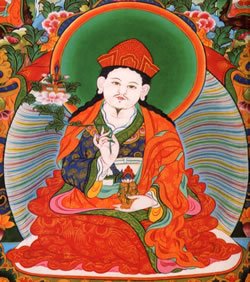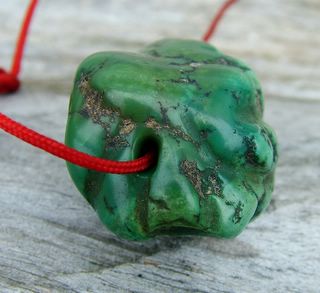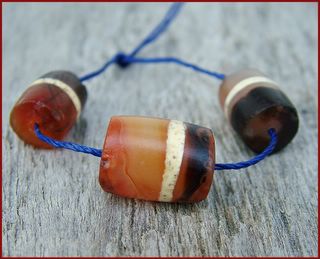Saturday, March 25, 2006
Some Tibetans believe that dZi beads are the dung of the sacred Garuda bird. The Garuda is traditionally known to be the enemy of the Nagas (snake spirits) and is often depicted with a snake (symbolic of the Naga) in its mouth. Probably because of this connection, dZi are used as an antidote for sickness caused by Nagas, which are normally very difficult to cure. Usually naga sickness is associated with problematic skin or diseases such as leprosy. In traditional Tibetan medicine dZi are mixed with 69 other ingredients to form precious pills called Ratna Samphel.
Thursday, March 09, 2006

Image: Chokgyur Lingpa (1829-1870) was one of the major tertons (revealer of hidden Dharma treasures) in Tibetan history.
"Chokling also discovered the Sabdün Phurba. To take out this terma, he dug a hole in a small rock. Looking inside, he saw 75 kilaya daggers emitting sparks of fire. He took the main phurba which was made of zi stone. The terma teaching of Sabdün Phurba was written on yellow parchment on the knot of the phurba. This phurba is now in the possession of H.H. Karmapa . Dazang Rinpoche has another phurba and Sabchu Rinpoche in Nepal has the consort phurba. Discovering many other amazing termas in similar ways, his fame grew and so did the number of his attendants and disciples" Excerpt taken from the short biography on the life of Chogyur Lingpa.
"Chokling also discovered the Sabdün Phurba. To take out this terma, he dug a hole in a small rock. Looking inside, he saw 75 kilaya daggers emitting sparks of fire. He took the main phurba which was made of zi stone. The terma teaching of Sabdün Phurba was written on yellow parchment on the knot of the phurba. This phurba is now in the possession of H.H. Karmapa . Dazang Rinpoche has another phurba and Sabchu Rinpoche in Nepal has the consort phurba. Discovering many other amazing termas in similar ways, his fame grew and so did the number of his attendants and disciples" Excerpt taken from the short biography on the life of Chogyur Lingpa.
Photo: His Holiness the 16th Gyalwa Karmapa
"On the fifteenth day of the ninth month of the male iron dragon year (1940) he traveled to Tsurphu, visiting the Penchen monastery on the way. In that place there was a statue of the Protector Zhing Kyong, riding on a horse. As soon as Karmapa approached the horse it started to neigh, much to the surprise of everyone. He proceeded to Dam Chung, where the main Deity offered him a large unpierced nine-eyed Zi stone, a type of precious banded-agate. The party reached Tsurphu on the eleventh day of the eighth month of the female iron snake year (1941)"
Taken from a short biography of the 16th Karmapa
Wednesday, March 08, 2006
Above: Detail from a Tibetan Thangka displaying a man holding a coral branch.
The Tibetan Medical system was introdcued in the 8th Century CE by the accomplished master, Yutog Gonpo the Elder. It is thought that these early medical texts were influenced by the Ayurvedic medical systems of India, and also Chinese and Persian medicine. In the previous century, the Tibetan King Songsten Gampo (617-698) had already invited great scholars and doctors from China, India and Persia. This also helped to establish the Tibetan writing system. These early texts did not become well known until Yutog Gonpo the Younger (1126-1212) merged these texts with his own medical treatise known as the 'Four Tantras'. They were completed in the 12th Century.
The first 'illustrated' Tibetan medical texts were probably the Blue Beryl treatise of Sangye Gyamtso (1653-1705) and this clearly shows that coral was an important and prized ingredient in many medical treatments. There also many Thangka paintings from as early as the 14th century, that show red coral branches as precious offerings. The fact that coral was valued as a medicinal ingredient in the Four Medical Tantras (12th Century), shows us that it was already deeply rooted in Tibetan culture at this time.
The first 'illustrated' Tibetan medical texts were probably the Blue Beryl treatise of Sangye Gyamtso (1653-1705) and this clearly shows that coral was an important and prized ingredient in many medical treatments. There also many Thangka paintings from as early as the 14th century, that show red coral branches as precious offerings. The fact that coral was valued as a medicinal ingredient in the Four Medical Tantras (12th Century), shows us that it was already deeply rooted in Tibetan culture at this time.
Above: Antique mediterranean coral sourced in Nepal.
In Tibetan Medicine there is a precious healing pill that includes coral as a main ingredient. It is said that this pill was formulated in ancient times and called the 'Rinchen Byur-dmar 25' also known as RINCHEN JUMAR-25 (Precious Coral-25 ) "It is prescribed for headaches, fainting, brain afflictions, fever that has been caused by poisonous substances, neuritis and chronic diseases. It is also believed to counteract stiffness and paralysis originating in the nervous system". There is also a pill said to originate from the 13th Century called the Rinchen Ratna bsam-pel (Precious Wish Fulfilling Jewel). It contains detoxified mercury, dZi, coral, turquoise and many other semi-precious stones.
Tibetans were not just using this material for medicine but more widely for personal adornment. We can also find a large number of early Tibetan statues and tantric ritual implements that have been inlaid with coral and various semi-precious stones. From the 1700s onwards there certainly seems to be an increase in mediterranean coral available to Tibet and the Himalayan regions. Many artifacts from this period show that coral was a popular material, because it is visible in all forms of Tibetan art and jewellery.
It is possible that the carnelian beads known as Pema Raka were once the most common and desirable of all the 'red' beads. When the mediterranean coral trade increased, the Pema Raka probably became less desirable, with Tibetans favouring the more exotic imported ocean coral. In today's marketplace, coral is by far the most expensive of all the orange/red Himalayan beads. It is also scarce due to mediterranean coral trade bans and has therefore become even more sought after. We also see many imitation coral beads in the marketplace to satisfy this demand. Pema Raka beads are sometimes referred to as 'poor man's coral', but I do not feel these beautiful beads were ever a substitute for red coral. Pema Raka (carnelian) may have been introduced long before coral became popular in Tibet.
Tibetans were not just using this material for medicine but more widely for personal adornment. We can also find a large number of early Tibetan statues and tantric ritual implements that have been inlaid with coral and various semi-precious stones. From the 1700s onwards there certainly seems to be an increase in mediterranean coral available to Tibet and the Himalayan regions. Many artifacts from this period show that coral was a popular material, because it is visible in all forms of Tibetan art and jewellery.
It is possible that the carnelian beads known as Pema Raka were once the most common and desirable of all the 'red' beads. When the mediterranean coral trade increased, the Pema Raka probably became less desirable, with Tibetans favouring the more exotic imported ocean coral. In today's marketplace, coral is by far the most expensive of all the orange/red Himalayan beads. It is also scarce due to mediterranean coral trade bans and has therefore become even more sought after. We also see many imitation coral beads in the marketplace to satisfy this demand. Pema Raka beads are sometimes referred to as 'poor man's coral', but I do not feel these beautiful beads were ever a substitute for red coral. Pema Raka (carnelian) may have been introduced long before coral became popular in Tibet.
Above: Antique Pema Raka Bead
The vivid carnelian used in creating Pema Raka may have come from China. However, it has been suggested that the earliest Pema Raka may have been traded from Afghanistan. The red glass beads known as 'Sherpa Coral', which first appeared in the Himalayas towards the end of the 19th Century, were clearly designed to imitate red coral. They were affordable and their striking red colour made them an attractive alternative to coral and carnelian.
Subscribe to:
Comments (Atom)
























